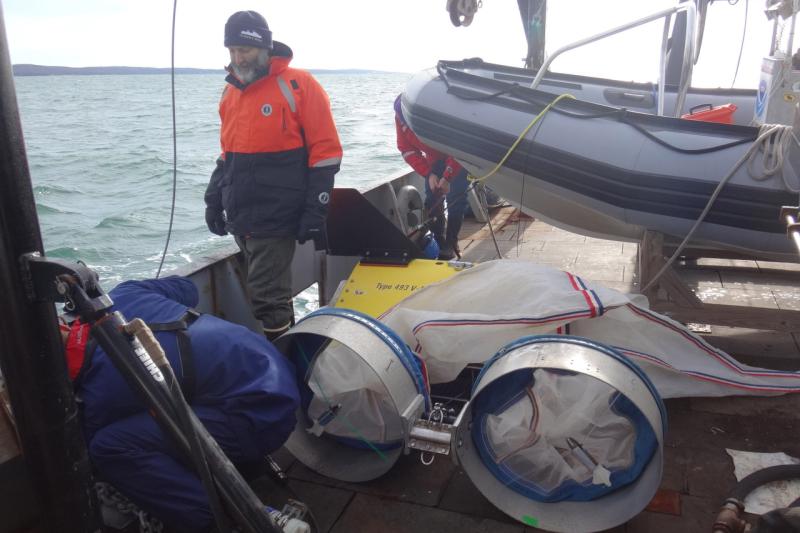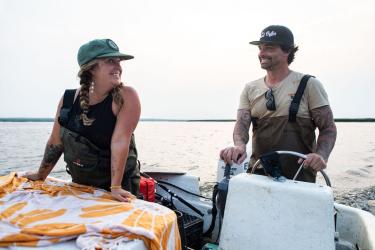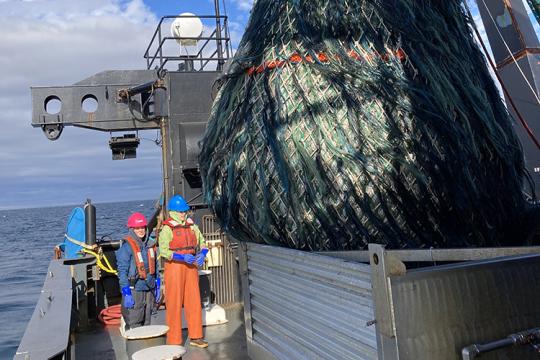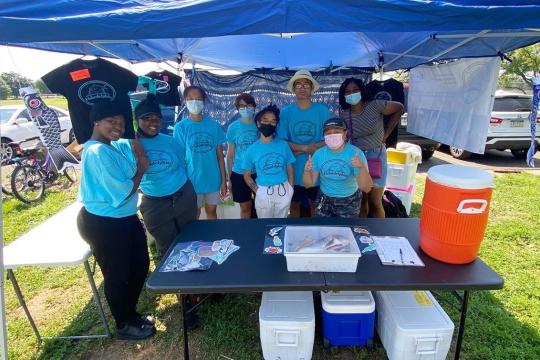We continue our series to introduce the people who work at the Northeast Fisheries Science Center. Each month we feature a new "face" from the Center's five laboratories. We share with you a bit about who they are, what they do at the Center, and what they enjoy doing in their spare time. Harvey Walsh from our Oceans and Climate Branch leads the Ecosystem Monitoring Program, which has been collecting data on the Northeast Continental shelf for more than 40 years. Learning about cool things is a key part of his job.
Where did you grow up?
I grew up in Minnesota fishing, hunting, and spending time outdoors. As a kid, my grandma would feed my three brothers and me breakfast and tell us to be home for dinner. We would spend lots of time riding bikes to places to fish, swim, or creek stomp, only coming home to get more food. My original goal was to get a job working with the Department of Natural Resources so I could spend my time outdoors.
Where did you go to school and what did you get your degree(s) in?
I got a bachelor of science degree in aquatic biology from St. Cloud State University in central Minnesota. I took classes in fisheries and limnology in pursuit of my goal to get a job with the Minnesota Department of Natural Resources. During my last quarter in college, I interned at a consulting firm and continued working there after graduation. That job was part-time, surveying feedlots that were impacting wetlands, and I was looking for something directly related to fisheries research. I love Minnesota, but I wasn’t getting interviews for the jobs I was applying to near home. So, I applied to graduate school and several NOAA jobs in North Carolina, Florida, and Texas.
I eventually got a phone interview for a biological science technician position with the NOAA Beaufort Laboratory. I was asked if I had any experience on ocean-going research vessels. I said, “No, but I’m willing to sail.” I figured it would be a good experience for a year or two. It was a short-term position, and I needed to add to my resume. I spent 50 days at sea in my first three months on the job! During those cruises I met some great colleagues who eventually introduced me to all the fishing spots in eastern North Carolina. They also helped me along in my science career.
That short-term position turned into a full-time position. I ended up staying 15 years in North Carolina, getting a master’s degree in zoology at North Carolina State University along the way. The Midwest was less appealing to me once I got a taste of saltwater. That was especially true as I got interested in studying larval and juvenile fish that lived in the ocean and estuaries of the Southeast United States.
How did you come to work at the Northeast Fisheries Science Center?
My wife and I made big career and life changes after spending over a decade in North Carolina. I took a position as a research associate in the Biology Department of the Woods Hole Oceanographic Institution. I worked on projects that studied animal movements in marine environments. I got to work in a lot of cool places including Belize, the Great Barrier Reef of Australia, and the Red Sea.
After a few years, I heard about a fishery biologist job opening in the Oceanography Branch (now the Oceans and Climate Branch) at the Northeast Fisheries Science Center. They were looking for someone to work on the Ecosystem Monitoring (EcoMon) Program. EcoMon conducts multi-disciplinary research cruises in the Northeast U.S. Shelf Ecosystem. I was hired to assist with the plankton sampling part of the program. I sailed on cruises and worked with the 30 years of larval fish data to improve its use in products used for science and management.
What do you do at the Science Center?
I now lead the EcoMon program, which means I spend a lot of time coordinating with partners from other NOAA programs, government agencies, and universities. We collect data to help manage the ocean’s resources. We use our ship time and partnerships to collect a lot of different kinds of data to improve our understanding of the changes we are seeing in the ecosystem. We can also work with our science and management partners on how those changes impact fish and fishermen.
What do you like most about your position?
My career has given me the opportunity to visit and study lots of places and fish. My job continues to provide me with the opportunity to learn about all kinds of cool things. Our group works with many people with varying interests, expertise, and backgrounds. For example, observers who sail with us identify and count the seabirds, marine mammals, and sea turtles they see during our cruises. It is neat to visit the research vessel's flying bridge and learn about the animals that we see on our cruises.
My favorite seabird is the dovekie because it is like a little bath toy out in the vast ocean. Dovekies don’t fly so well but are great swimmers, so sometimes you can watch them barrel through a wave instead of flying over it. Talking with others about their research sometimes lets them pass on some of their knowledge and passion, which is very inspiring.
What are some of your hobbies?
I like to spend as much time as I can with my family. We like to hike, kayak, camp, and are finding more places and time to fish.
Our entire family is active in scouting. My wife and I volunteer with one of the local Cub Scout packs. It is rewarding to connect kids with the outdoors and their community.
For more information, please contact Shelley Dawicki.










